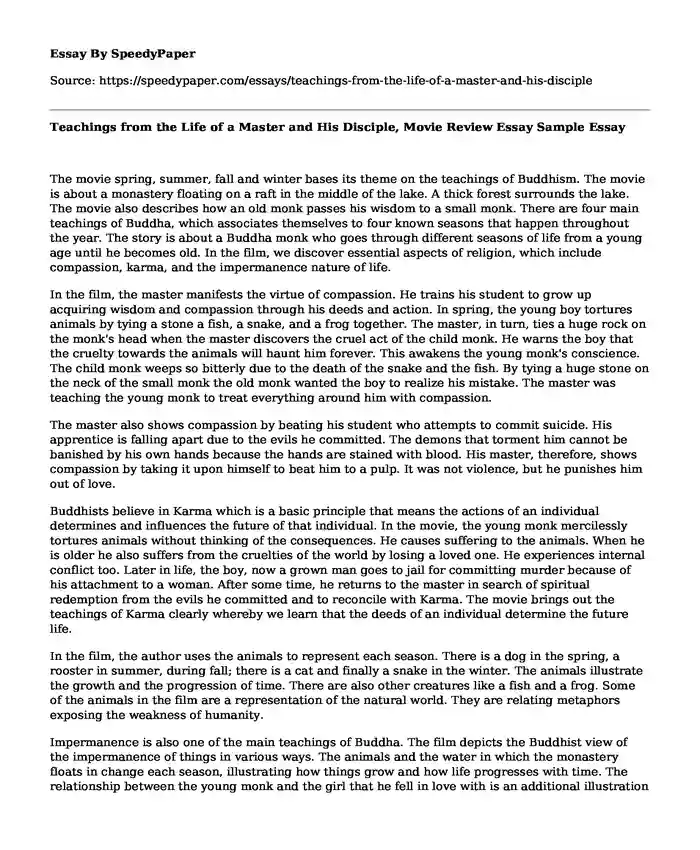The movie spring, summer, fall and winter bases its theme on the teachings of Buddhism. The movie is about a monastery floating on a raft in the middle of the lake. A thick forest surrounds the lake. The movie also describes how an old monk passes his wisdom to a small monk. There are four main teachings of Buddha, which associates themselves to four known seasons that happen throughout the year. The story is about a Buddha monk who goes through different seasons of life from a young age until he becomes old. In the film, we discover essential aspects of religion, which include compassion, karma, and the impermanence nature of life.
In the film, the master manifests the virtue of compassion. He trains his student to grow up acquiring wisdom and compassion through his deeds and action. In spring, the young boy tortures animals by tying a stone a fish, a snake, and a frog together. The master, in turn, ties a huge rock on the monk's head when the master discovers the cruel act of the child monk. He warns the boy that the cruelty towards the animals will haunt him forever. This awakens the young monk's conscience. The child monk weeps so bitterly due to the death of the snake and the fish. By tying a huge stone on the neck of the small monk the old monk wanted the boy to realize his mistake. The master was teaching the young monk to treat everything around him with compassion.
The master also shows compassion by beating his student who attempts to commit suicide. His apprentice is falling apart due to the evils he committed. The demons that torment him cannot be banished by his own hands because the hands are stained with blood. His master, therefore, shows compassion by taking it upon himself to beat him to a pulp. It was not violence, but he punishes him out of love.
Buddhists believe in Karma which is a basic principle that means the actions of an individual determines and influences the future of that individual. In the movie, the young monk mercilessly tortures animals without thinking of the consequences. He causes suffering to the animals. When he is older he also suffers from the cruelties of the world by losing a loved one. He experiences internal conflict too. Later in life, the boy, now a grown man goes to jail for committing murder because of his attachment to a woman. After some time, he returns to the master in search of spiritual redemption from the evils he committed and to reconcile with Karma. The movie brings out the teachings of Karma clearly whereby we learn that the deeds of an individual determine the future life.
In the film, the author uses the animals to represent each season. There is a dog in the spring, a rooster in summer, during fall; there is a cat and finally a snake in the winter. The animals illustrate the growth and the progression of time. There are also other creatures like a fish and a frog. Some of the animals in the film are a representation of the natural world. They are relating metaphors exposing the weakness of humanity.
Impermanence is also one of the main teachings of Buddha. The film depicts the Buddhist view of the impermanence of things in various ways. The animals and the water in which the monastery floats in change each season, illustrating how things grow and how life progresses with time. The relationship between the young monk and the girl that he fell in love with is an additional illustration of impermanence. The concept of impermanence comes about when the girl leaves him and goes for another man, demonstrating how the world is subject to constant change. Also, the images of a floating monastery floating on a raft depict the impermanence nature of the world. The monastery symbolizes how one may wake up and find a completely different life.
The master taught his disciple how to see himself through the eyes of the Buddha by teaching him the virtue of compassion. Also when the old monk finds young monk had sex with a girl at the monastery, the master did not reprimand him with anger. But he advised the boy that lust brings the desire to possess, which can likely lead to murder. This was a prophecy that came to pass because the young monk killed his wife due to the desire to possess. He, therefore, learned to see through the Buddha's eyes through his own experience. From the film, there is so much to learn about Buddhism. For instance, one should avoid the attachment to worldly things and desires because of their temporary nature. Lastly, nothing is eternal, everything changes and by having an attachment to something that is temporary leads to suffering.
Works Cited
Link film: http://dai.ly/xzkxf4
Cite this page
Teachings from the Life of a Master and His Disciple, Movie Review Essay Sample. (2022, Apr 25). Retrieved from https://speedypaper.net/essays/teachings-from-the-life-of-a-master-and-his-disciple
Request Removal
If you are the original author of this essay and no longer wish to have it published on the SpeedyPaper website, please click below to request its removal:
- Free Essay on Urban Planning Concepts
- Mandarin Oriental Business Proposal Essay Example
- Method of Data Collection - Free Essay in Data Analysis
- Telegraphy Essay Sample
- Argumentative Essay Sample on the Importance of Games
- Essay Example on Art Museum and Oleg Tselkov
- Paper Example of a Letter to Judge
Popular categories





